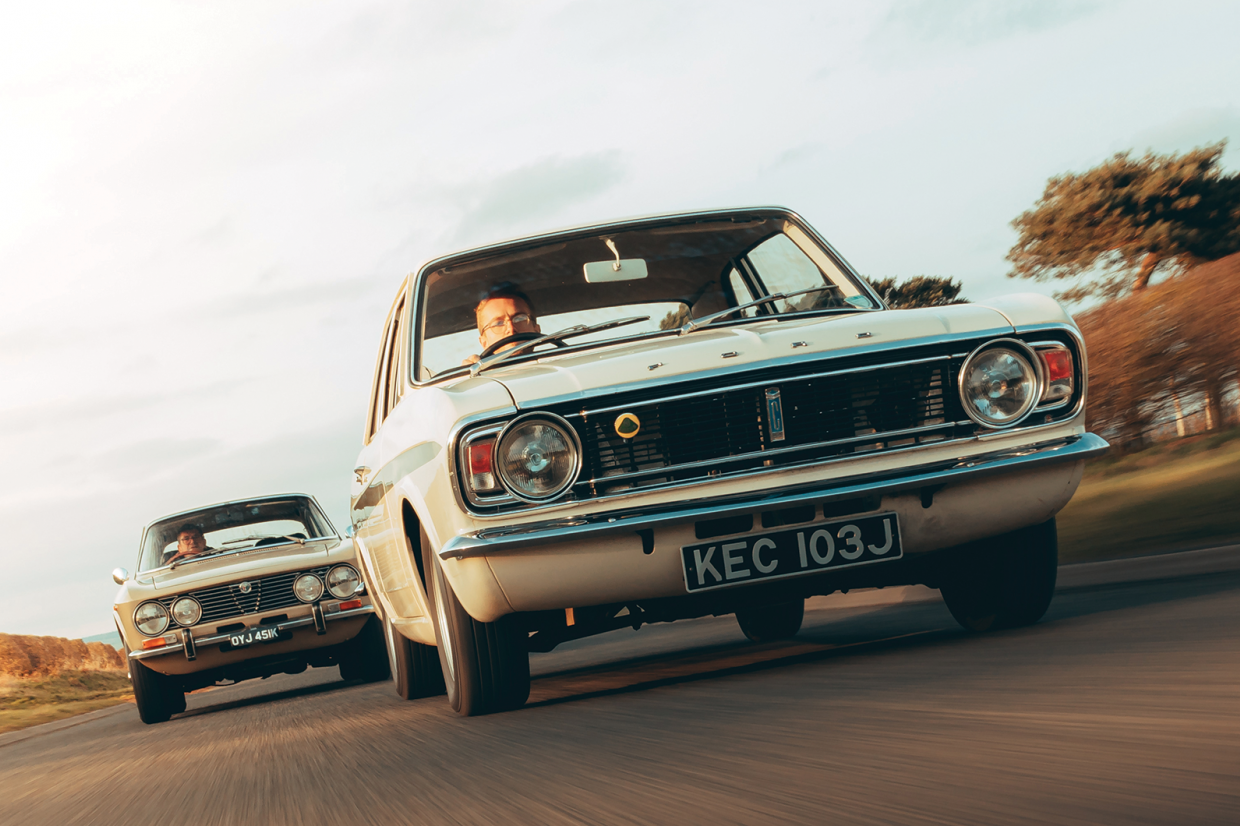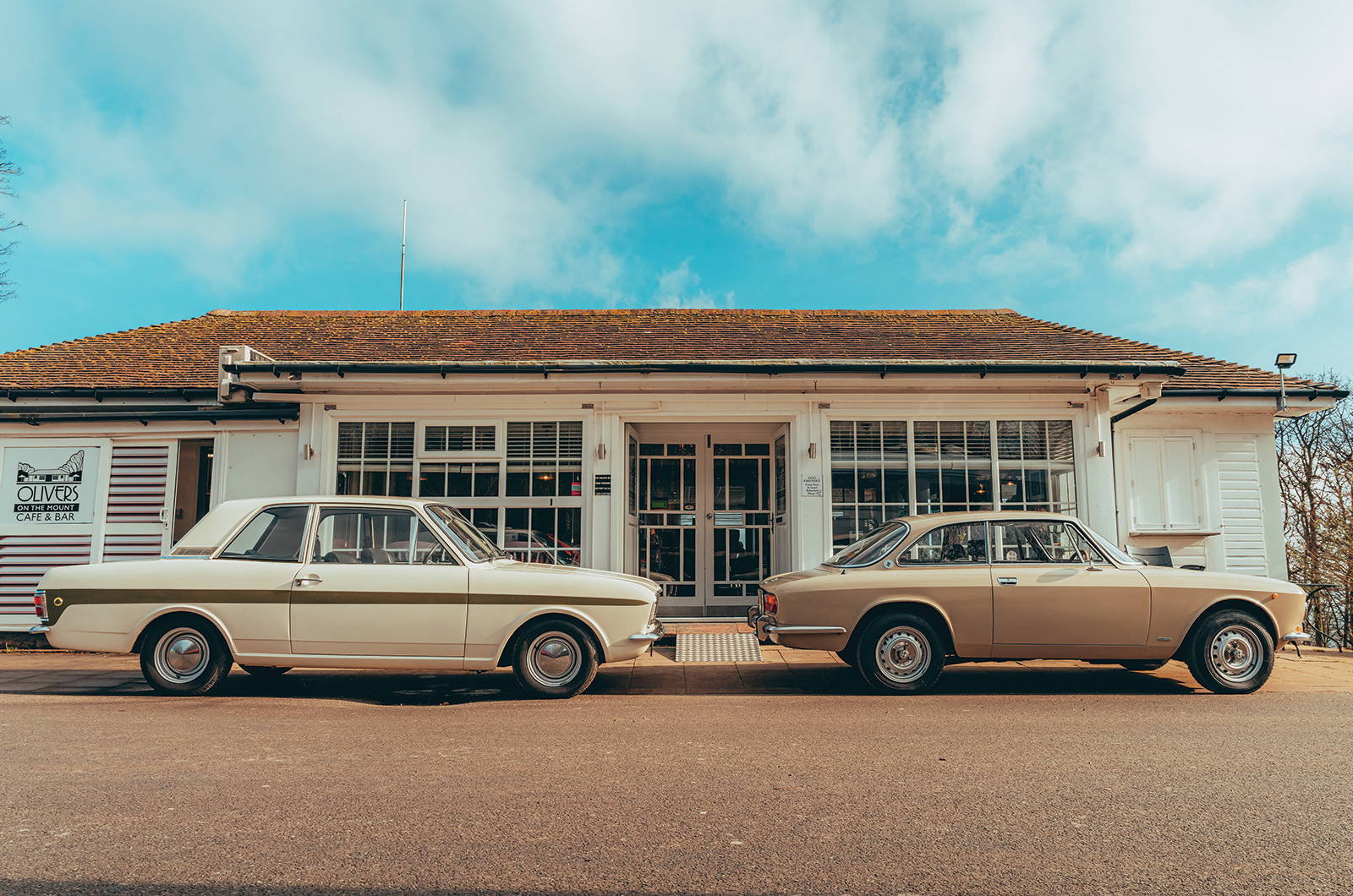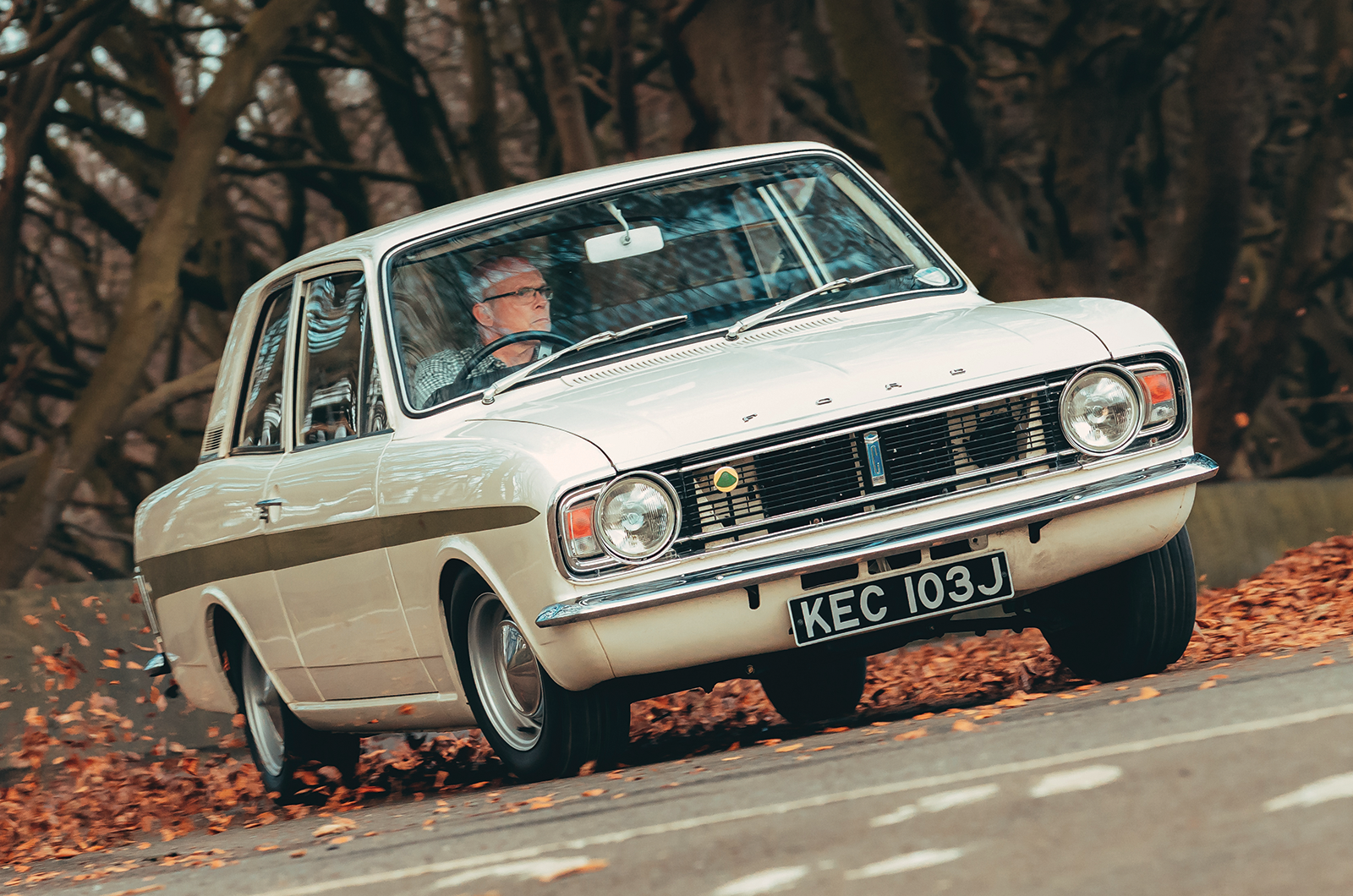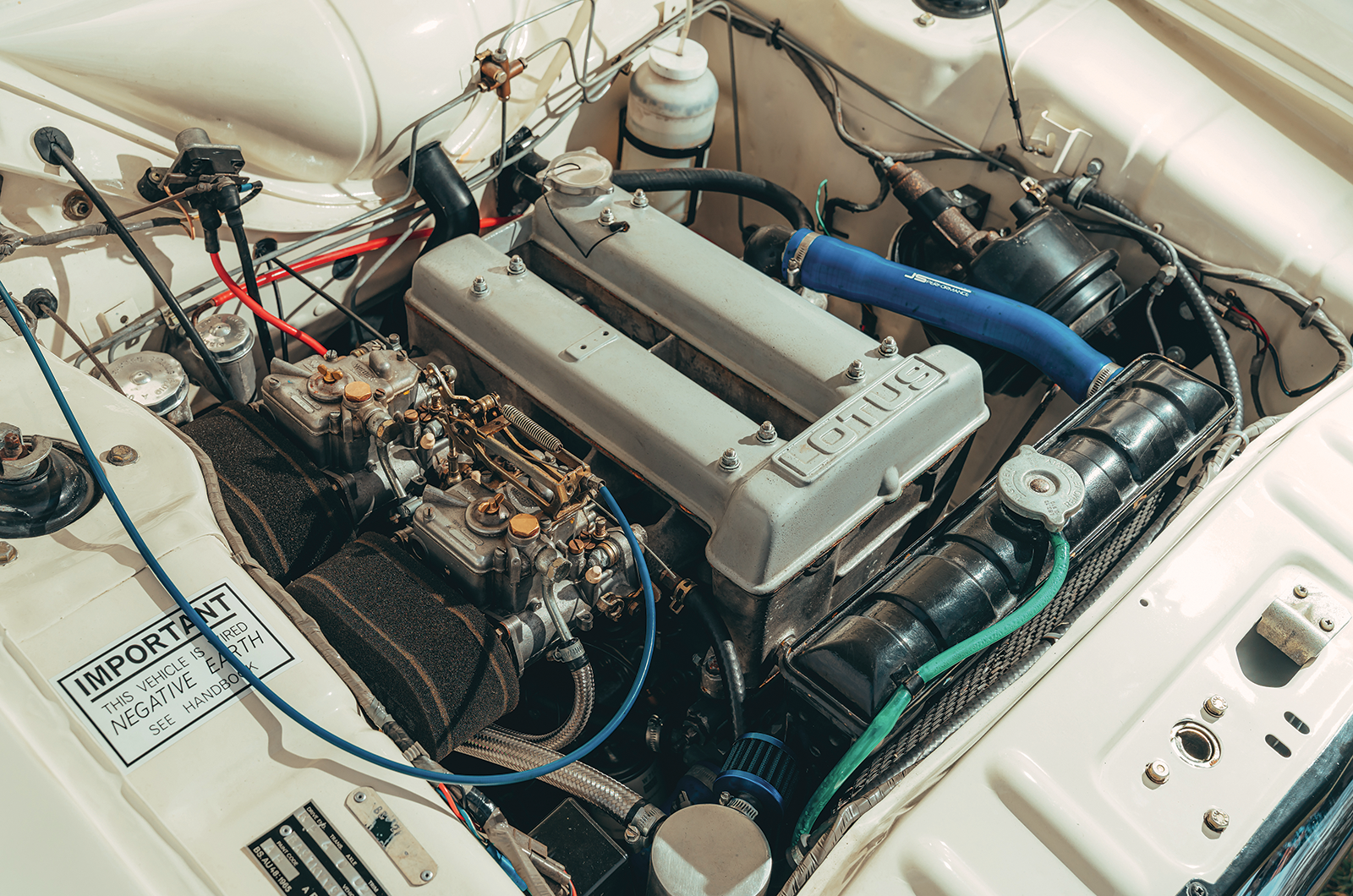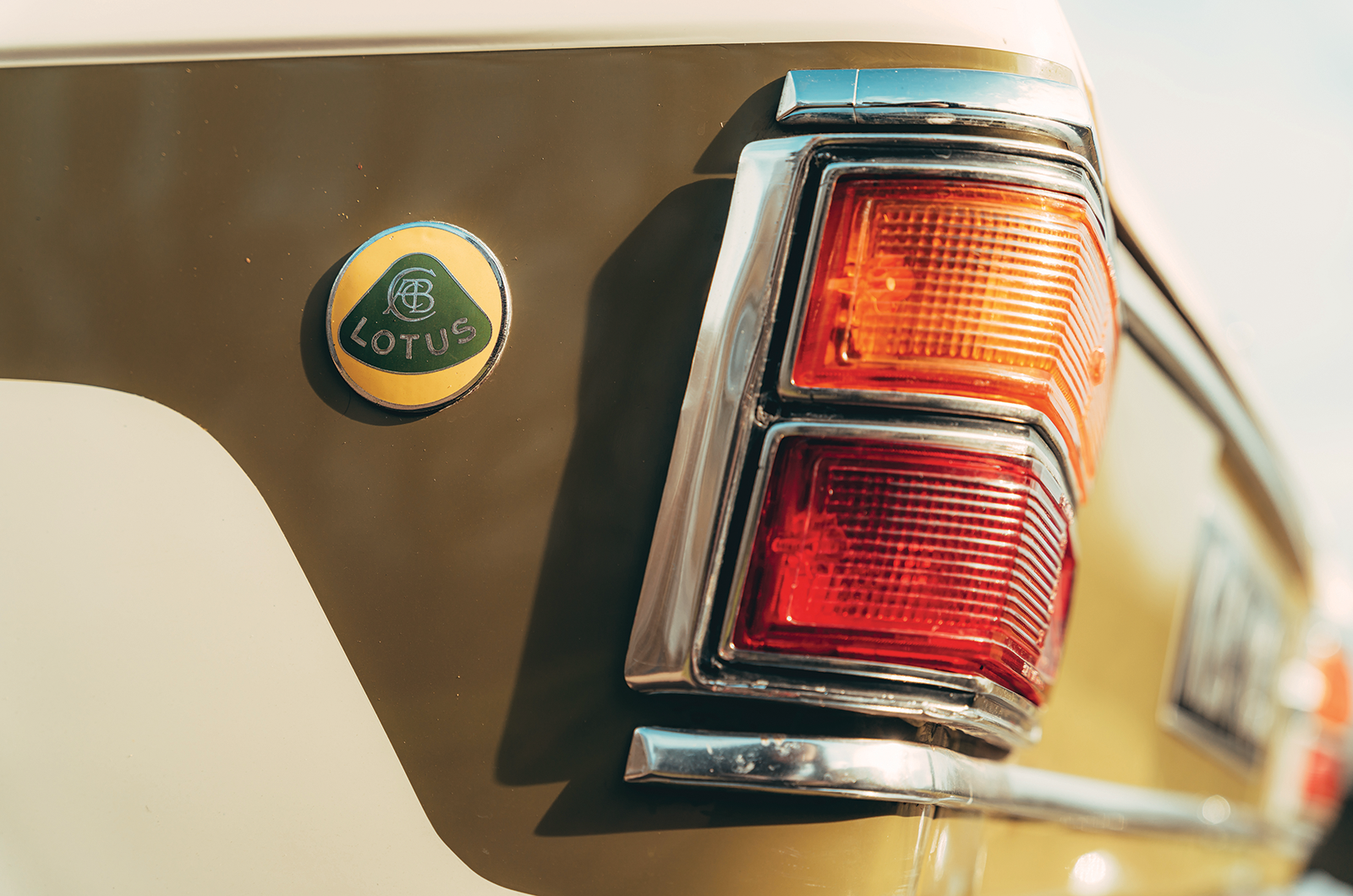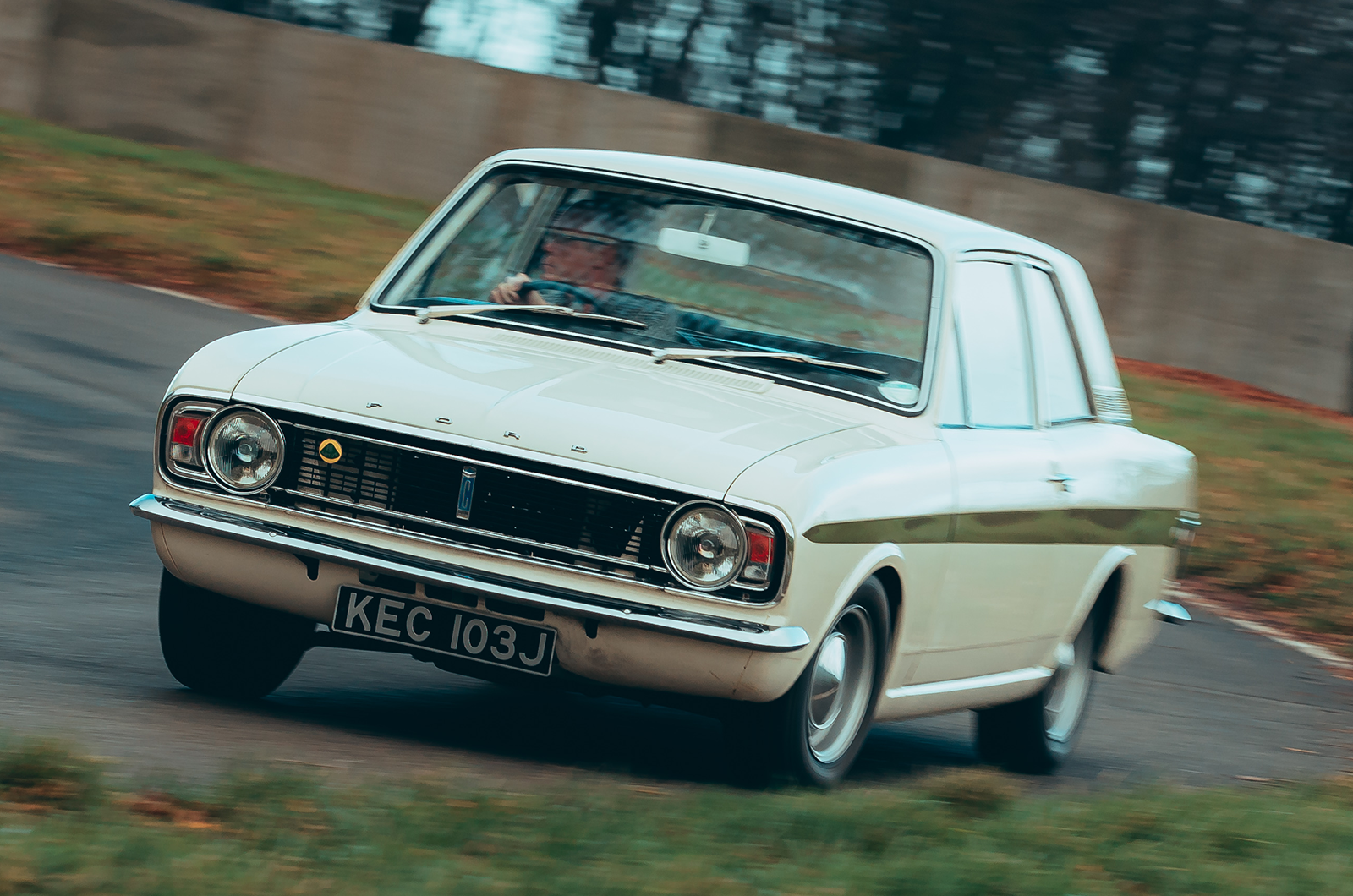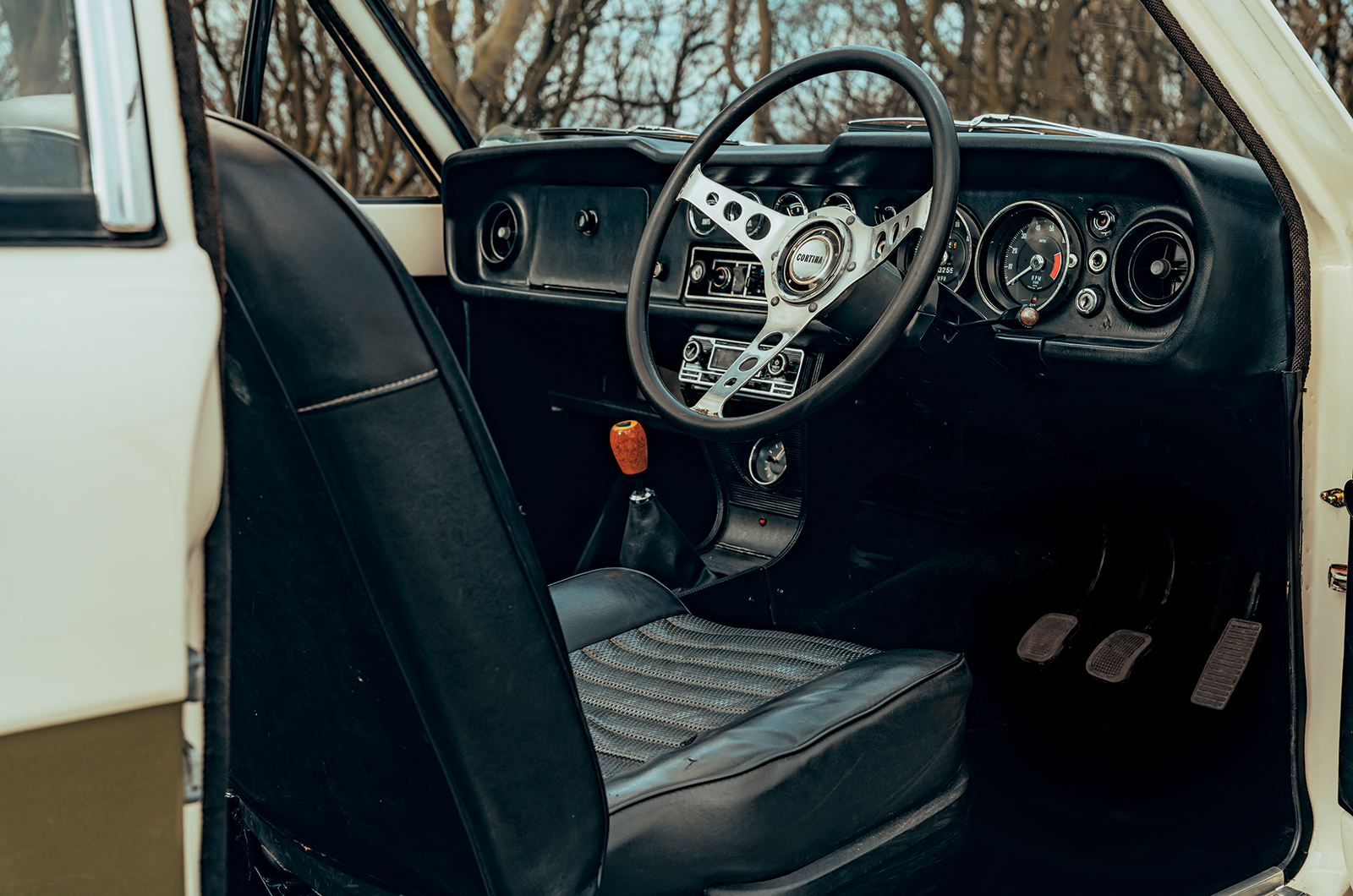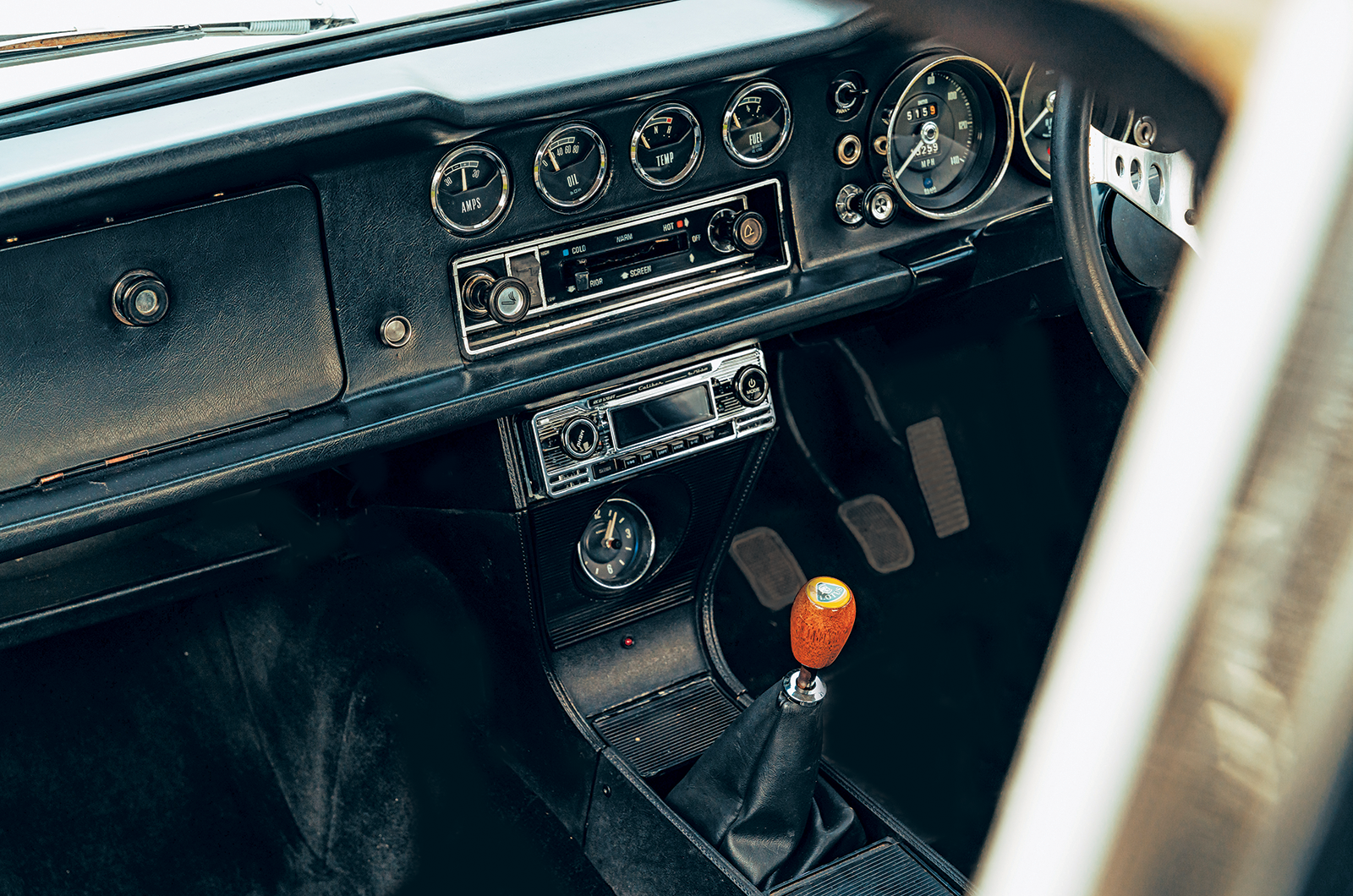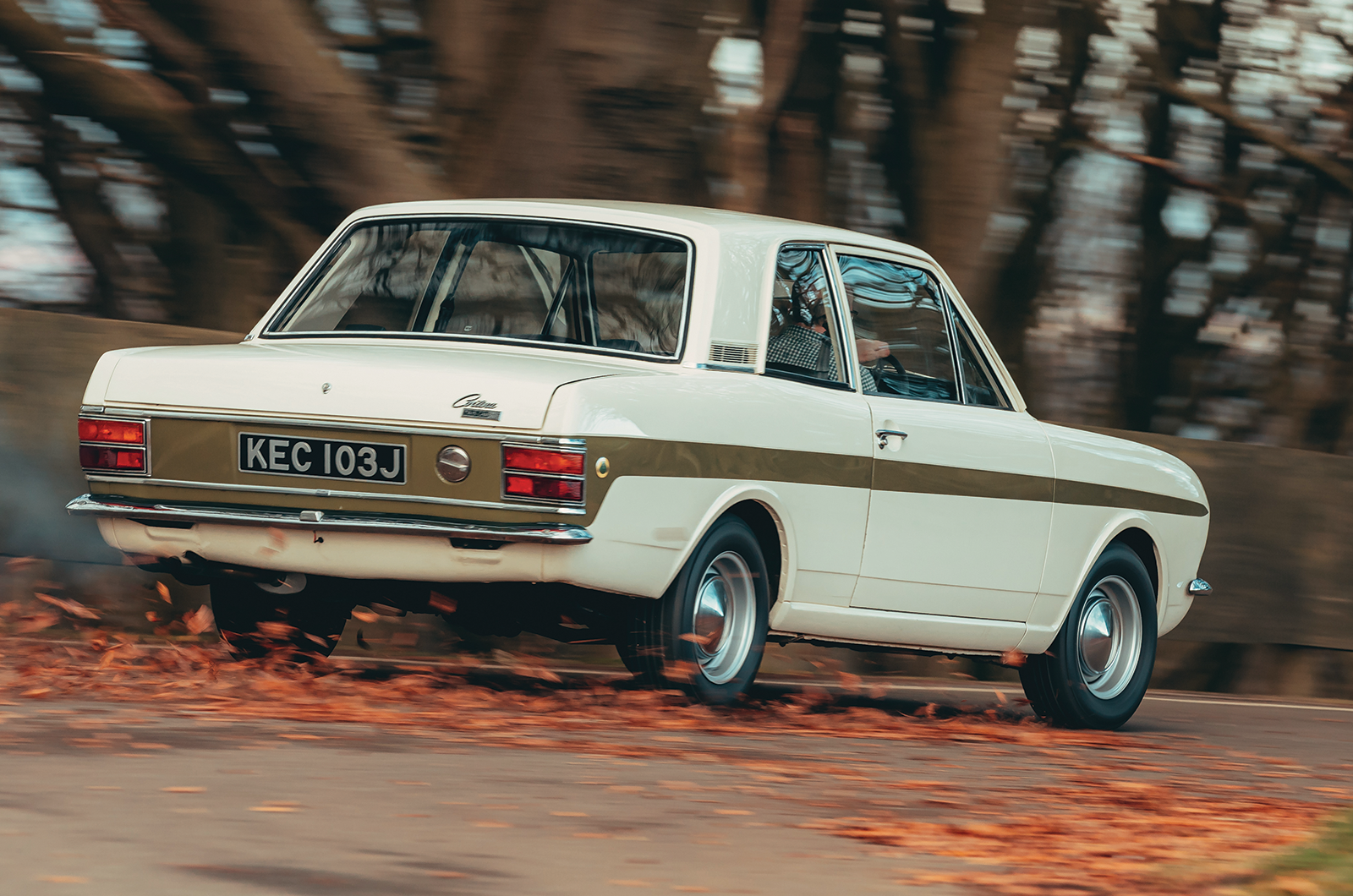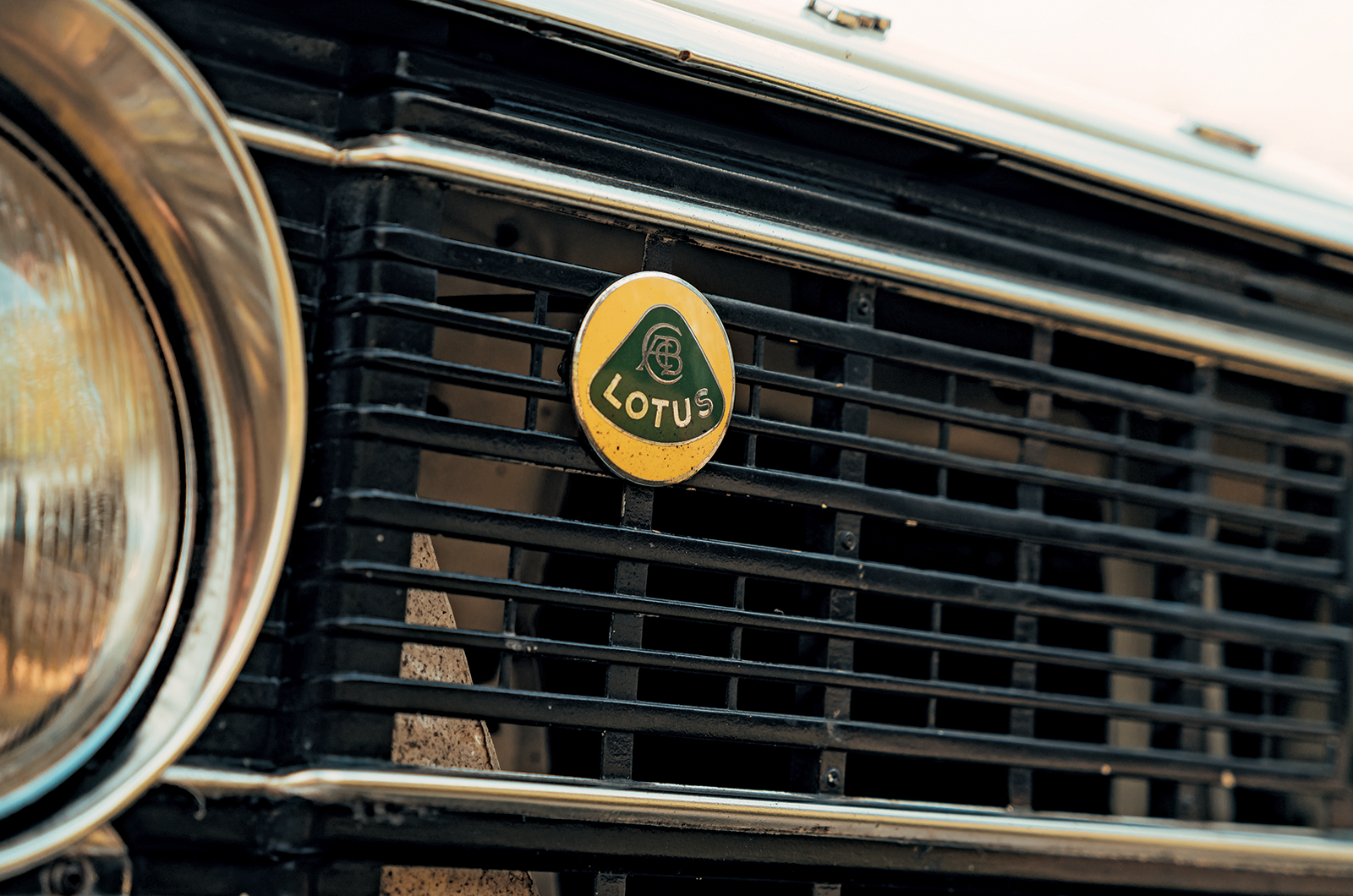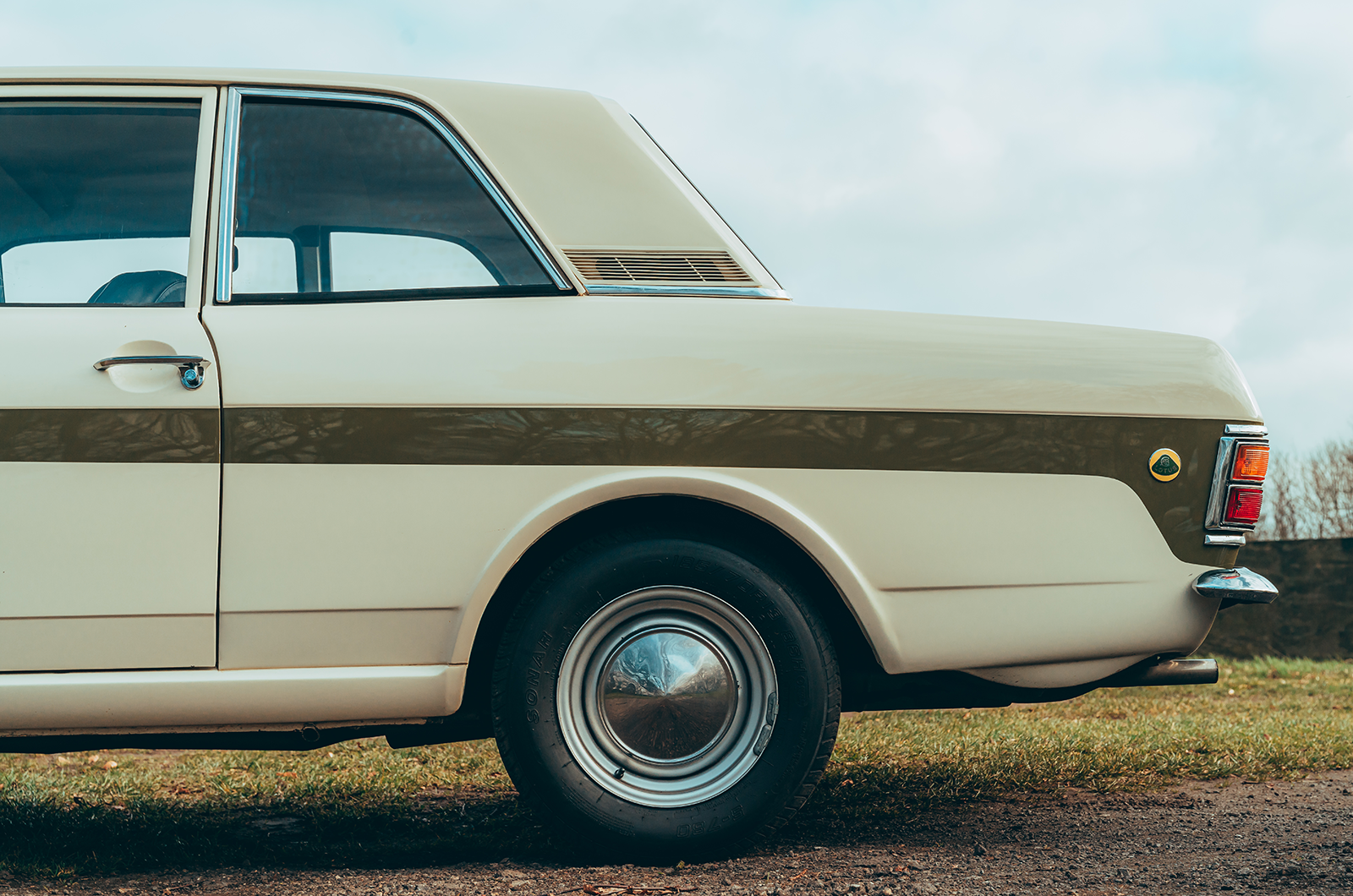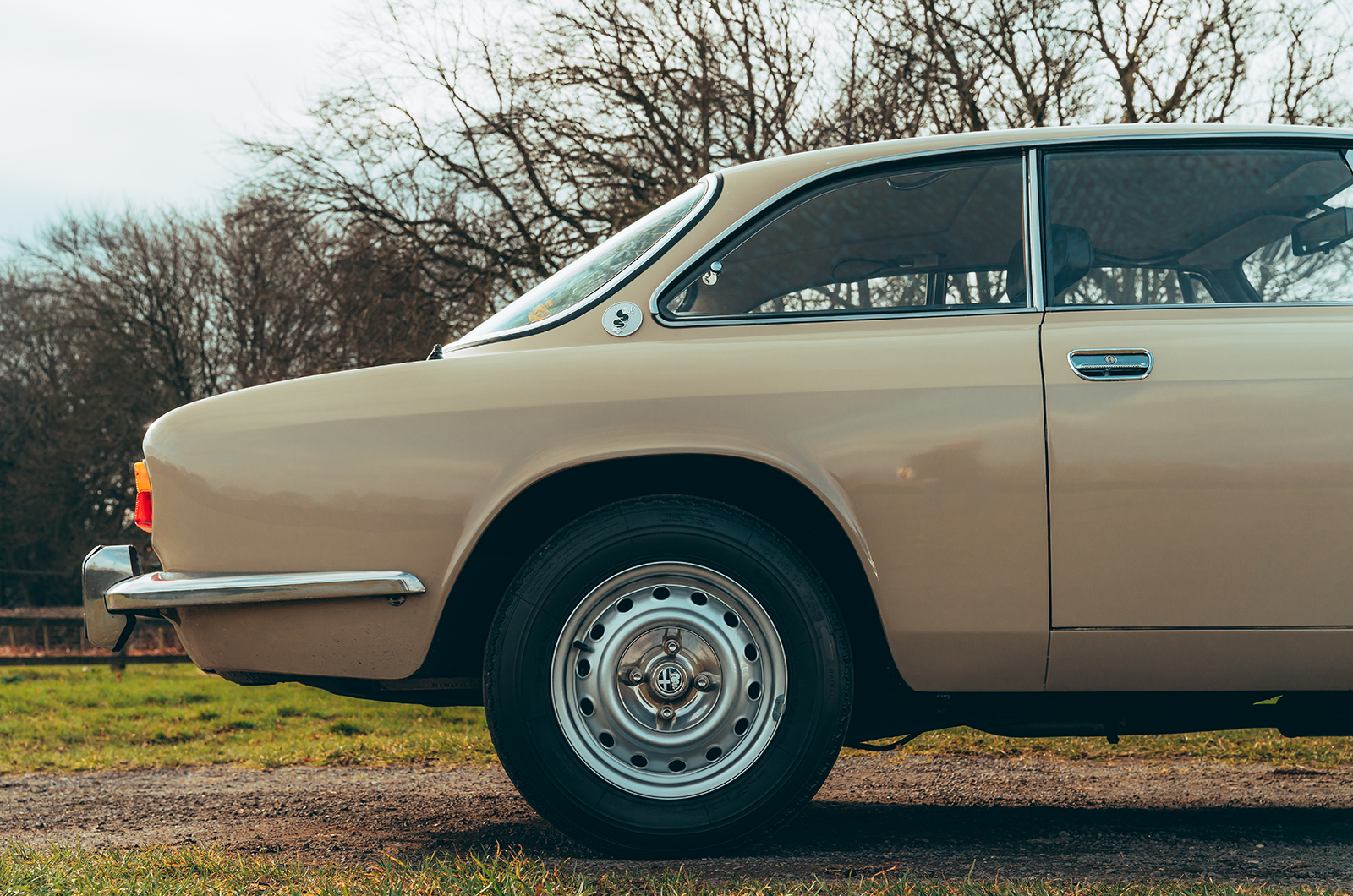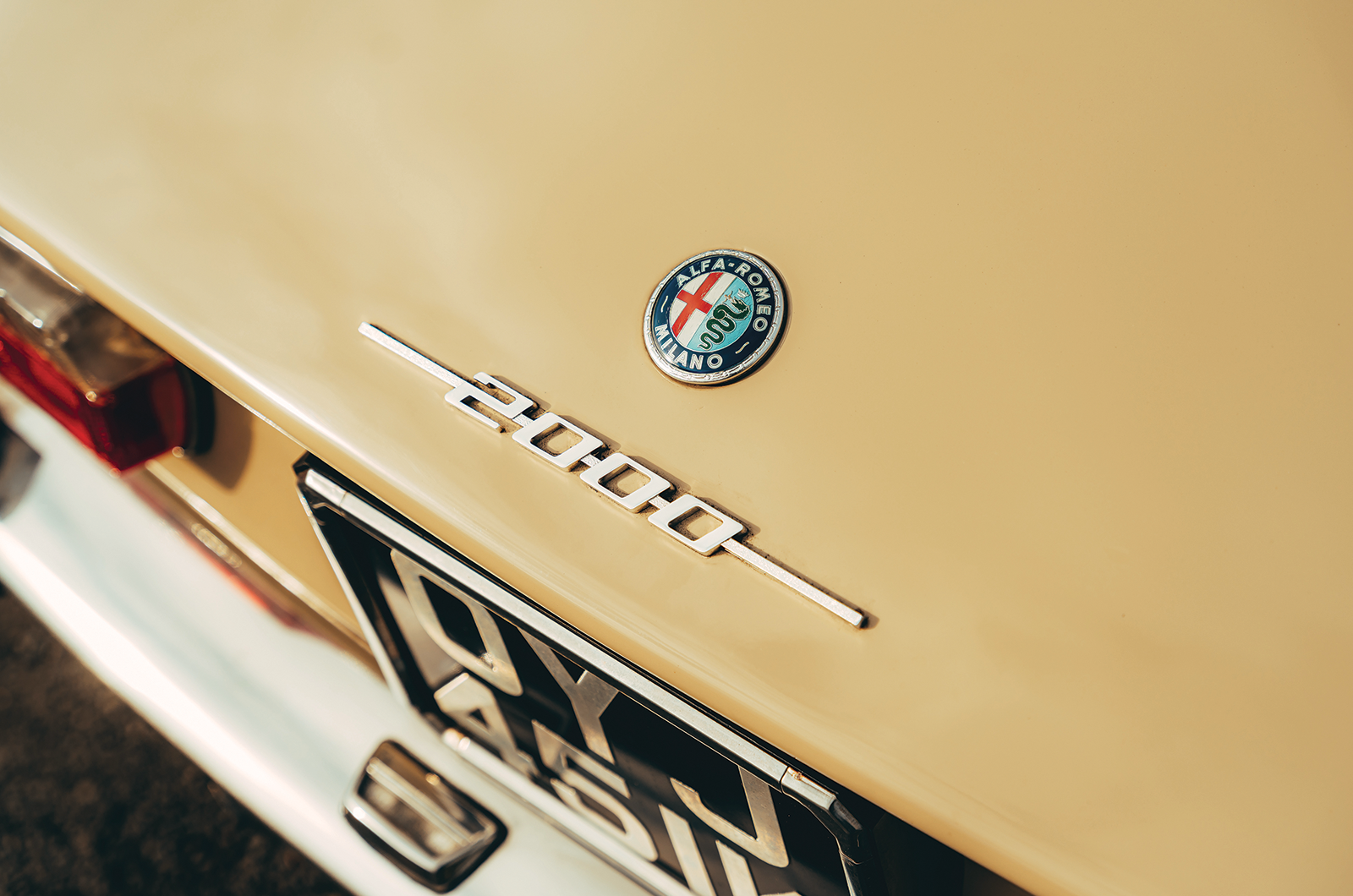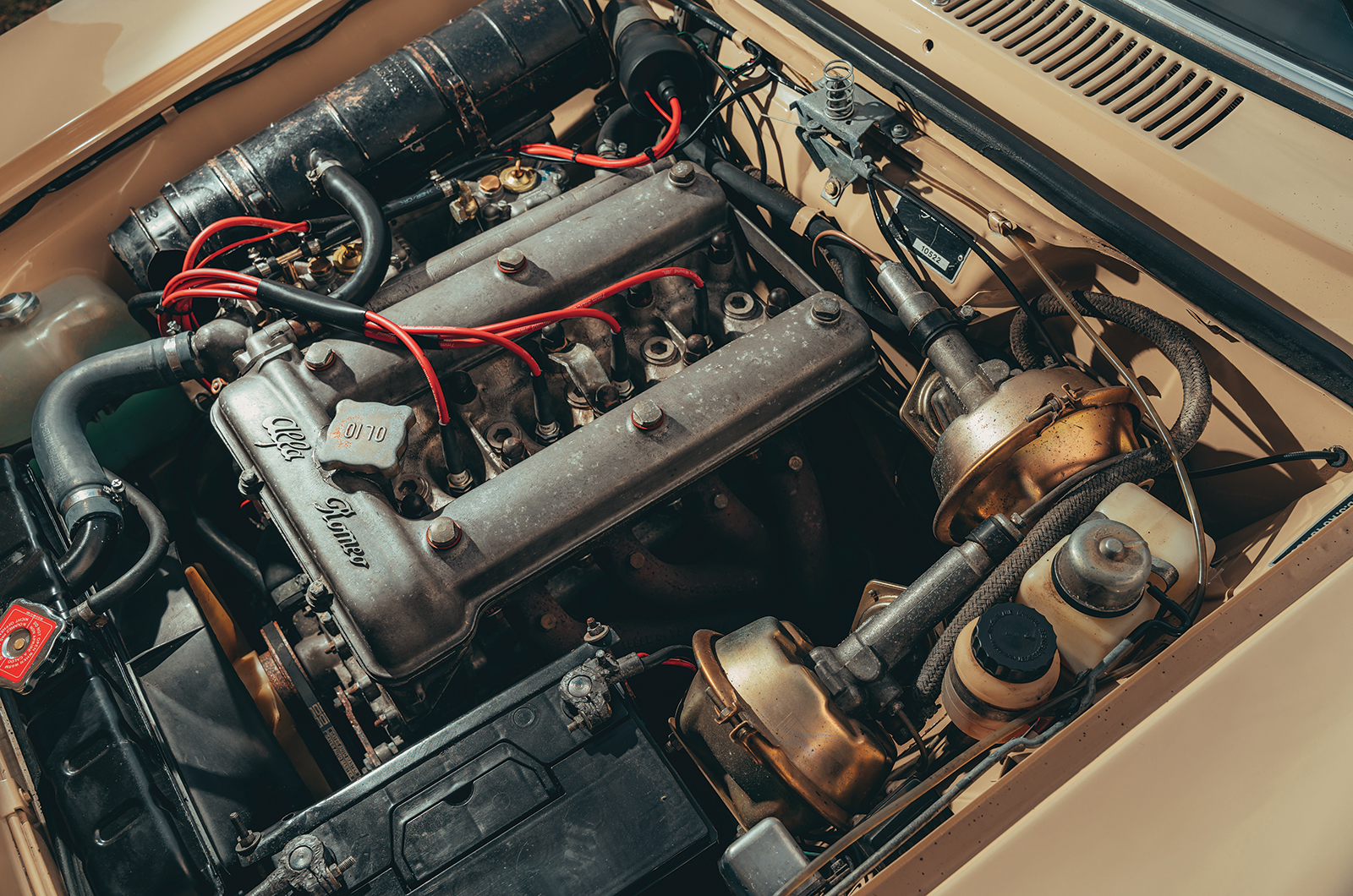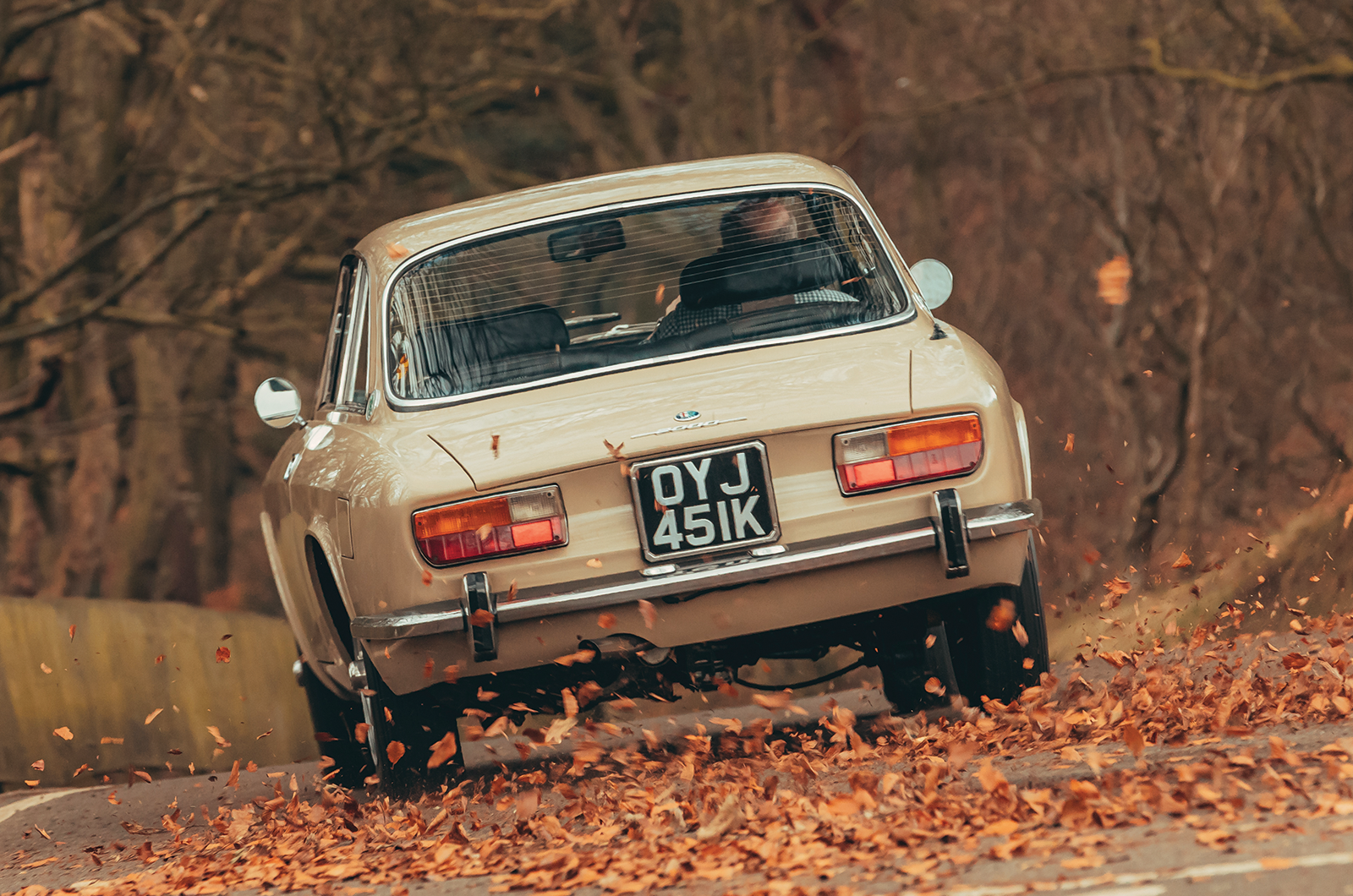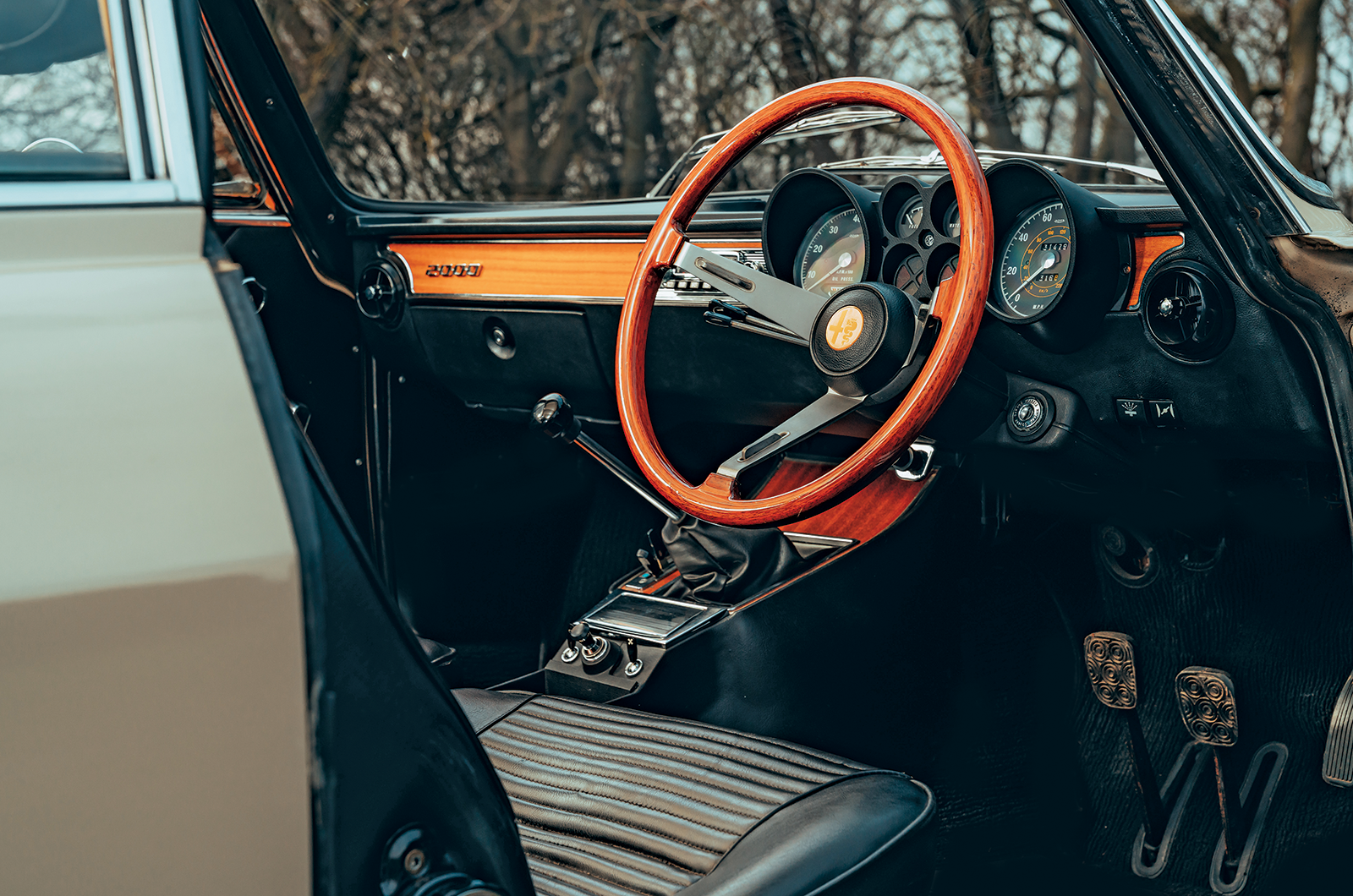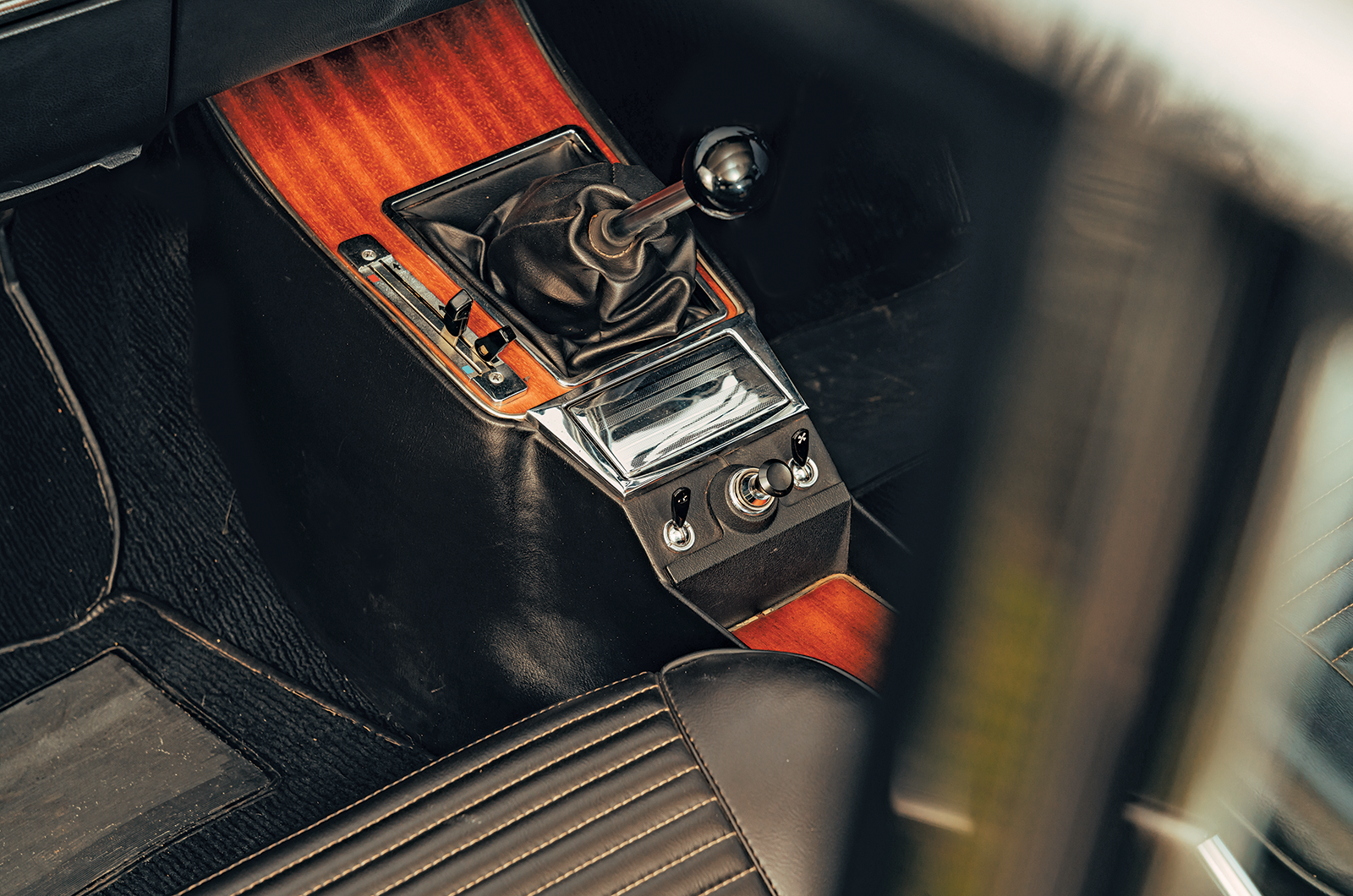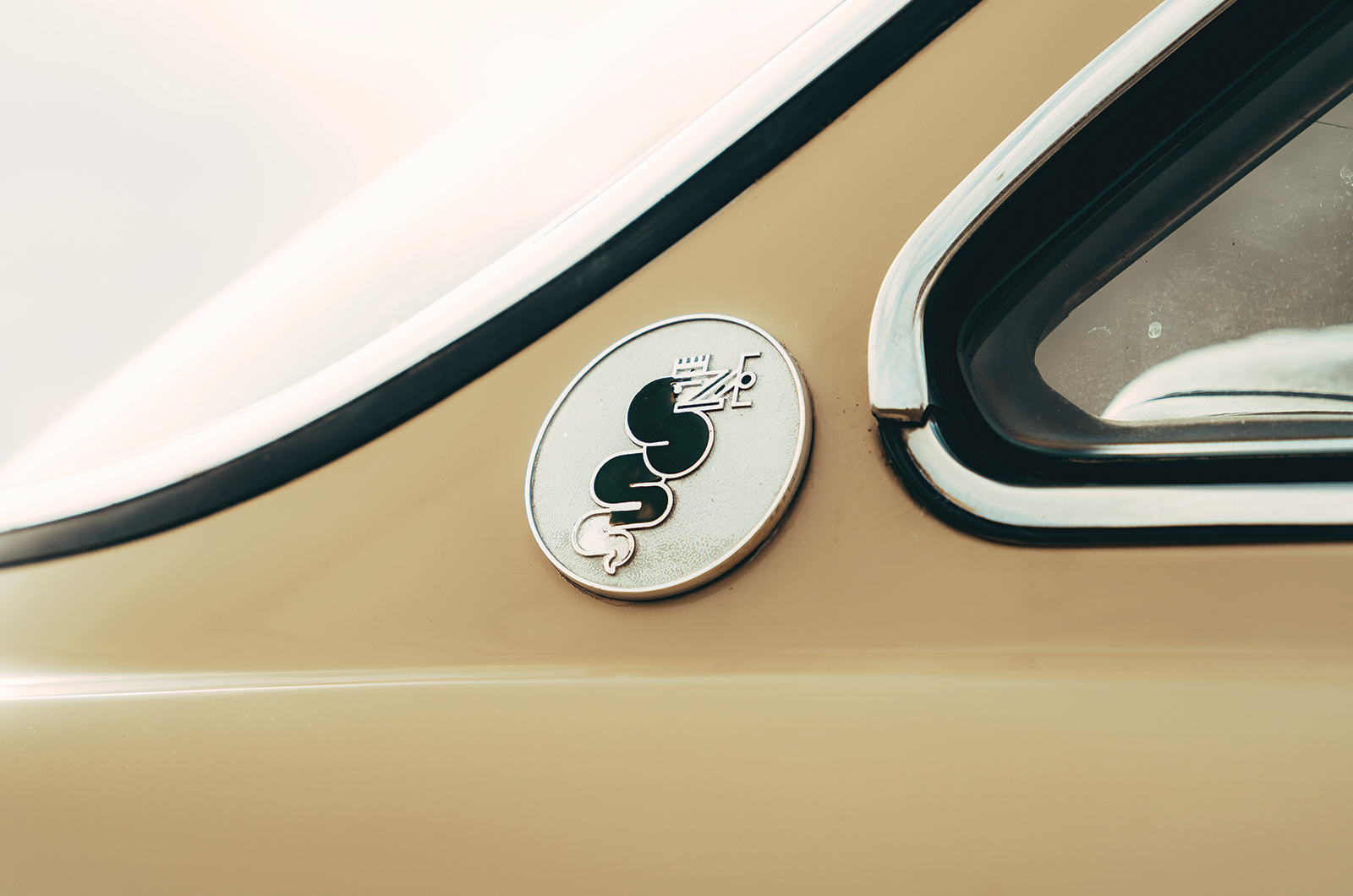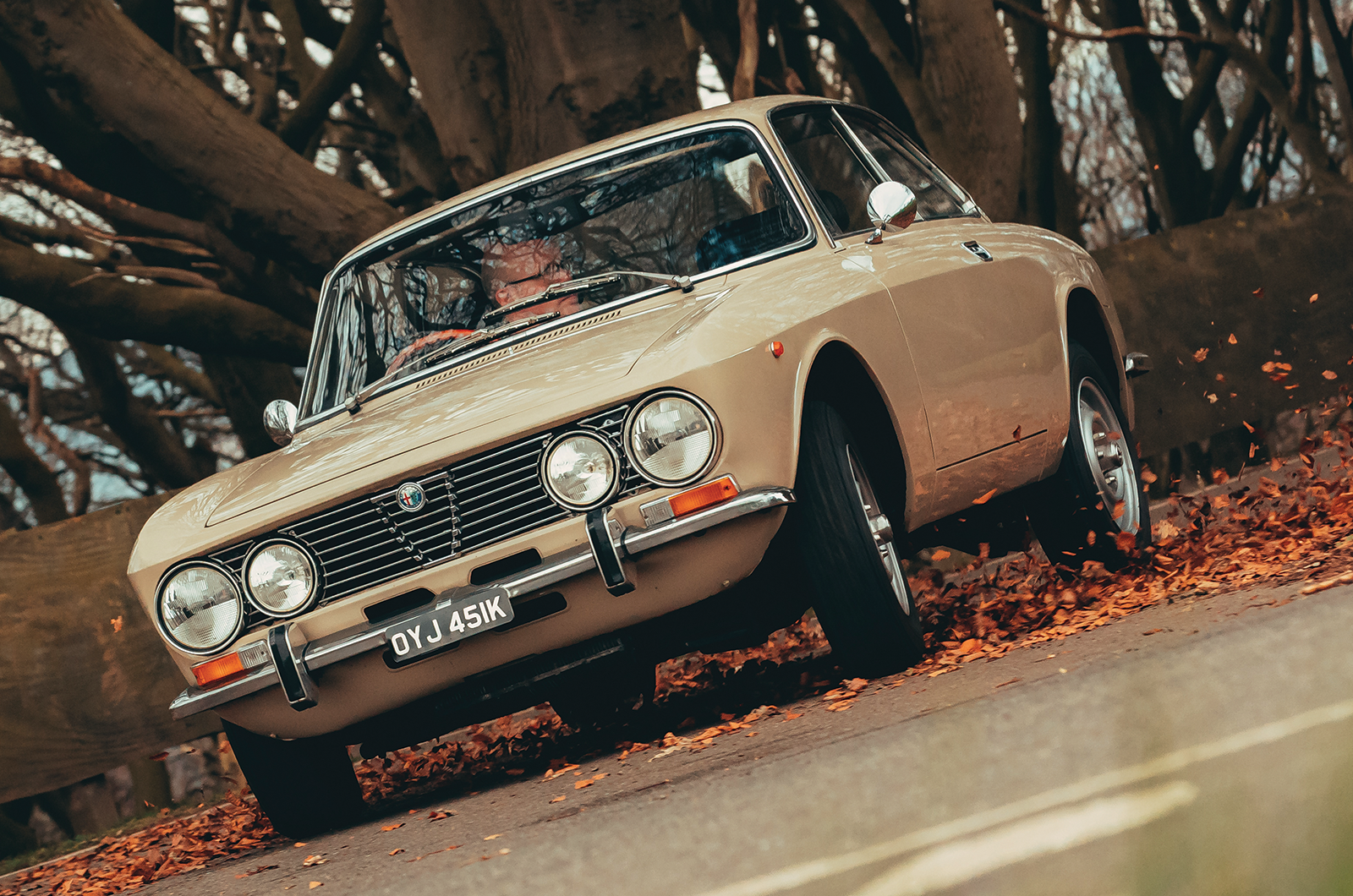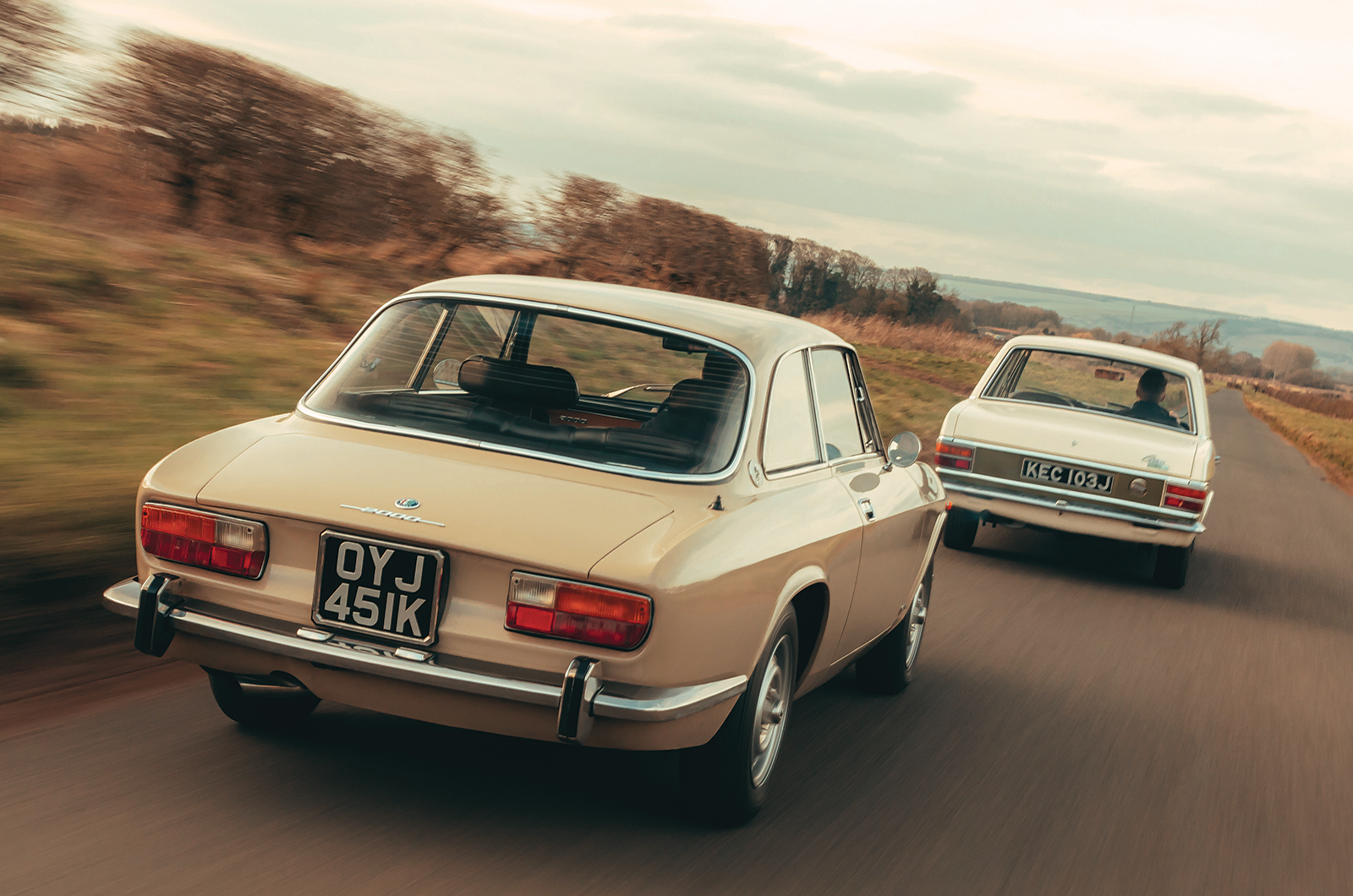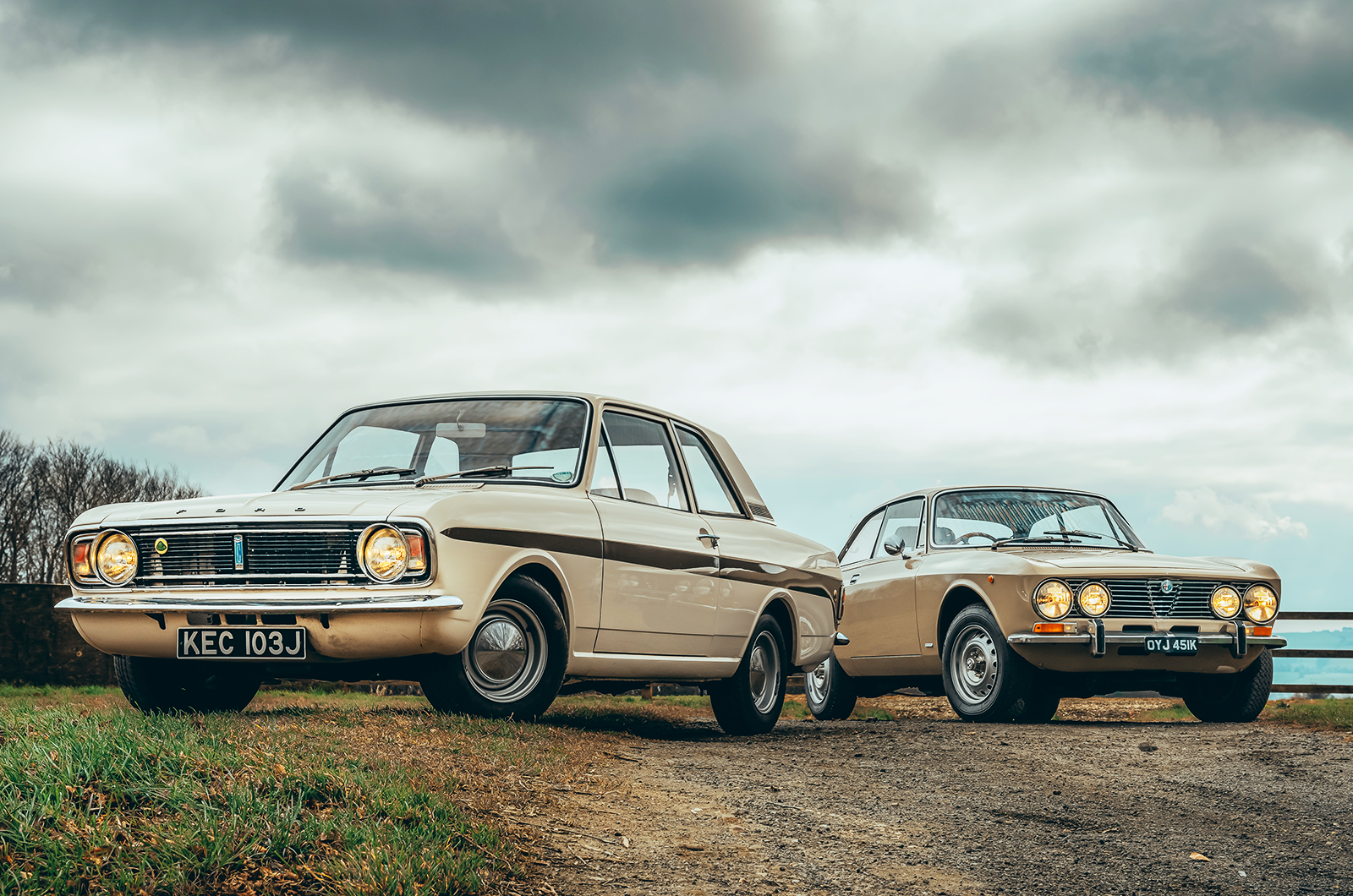Short gearing gives the Cortina a willing responsiveness on the hillclimb track, borne out by a respectable 0-60mph time of 11 secs, versus a 1750’s 11.2 secs (although it’s slower off the line than the 2000).
But out on the A64 it feels slightly breathless at cruising speeds and, combined with the sparsely trimmed and meagrely insulated cabin, progress is noisy.
Handling is marred somewhat by the steering, which is vague off the straight-ahead and lacks caster, meaning almost no self-centring out of turns (which may have been a quirk of this particular car).
Alfa Romeo’s twin-cam engine grew to 1962cc for the 2000 GTV
But in general, the Ford’s body control is tight for a ’60s car, and it’s nicely balanced, with strong front-end grip and a tendency to oversteer when pushing, even on our impromptu test track’s tighter corners.
Overall, the Ford offers what you’d expect: an honest if pretty raw driving experience, which, for a certain type of driver, would hit the mark every time.
Unless, that is, they approached the Alfa immediately afterwards.
The classic Alfa Romeo 2000 GTV retains its composure despite some body roll
Even ‘our’ car’s subtle hearing-aid beige can’t disguise the drama of Bertone’s rakish bodywork: the GTV looks more set to climb the Col de Turini than Oliver’s Mount.
It’s seven inches shorter and the same width as the Cortina, manifested in its less capacious cabin – especially in the rear, where legroom is compromised.
Subjectively, though, it’s instantly more enticing.
Like in the Cortina, you drop down on to a nicely bolstered vinyl seat, although here the facings are ribbed rather than perforated, with elegant head restraints on the front seats.
The Alfa Romeo 2000 GTV has an elegant wood-rimmed steering wheel, but the floor-mounted pedals need some familiarisation
Matching trim adorns the door cards, where there was bare metal in the Ford, and the quality of that trim is of a higher grade.
Facing you is a deeply dished, wood-rimmed steering wheel with a horn button in each spoke, framing a skeletal but attractive four-dial layout, with a large rev counter (incorporating an oil-pressure gauge) and speedometer flanking secondary clocks for fuel and water temperature.
A longish, chrome-topped gearlever sprouts from the centre console, which also houses the heater controls set into its wood-effect trim.
The Alfa Romeo’s five-speed gearbox is smoother than the Ford’s short-shifting unit
In short, the Alfa’s interior is elegantly designed and contoured, compared with the pared-down, more workaday cabin of the Ford.
That impression continues when you turn the GTV’s key.
With twin Webers and twin cams, the soundtrack at idle is similar to the Ford’s, if more subdued.
Floor-mounted pedals take some getting used to, and to avoid adopting a long-armed driving position you tend to sit with knees bent; the Cortina has the Alfa licked here.
Alfa Romeo’s famed serpent crest on the 2000 GTV
Pull away and the Alfa’s gearchange is smoother and more delicate, with a longer throw than the Ford’s short-shifting, more mechanical-feeling ’box.
Rolling refinement is in another league, with sufficient cabin insulation for occupants to contemplate long Alpine schleps.
If they did, they’d find the Alfa to be composed yet biddable in the twisties.
Like in the Ford, there’s some body roll as you press on, but the GTV is more composed – especially if you hit mid-corner surface imperfections – and feels less as if the body is pivoting around its front end.
The Alfa Romeo 2000 GTV’s limited-slip differential helps in slower turns
It also scores on the tight switchbacks of Oliver’s Mount by having a standard limited-slip diff, avoiding unnecessary inner-wheel spin on the exits.
That said, while the Alfa’s recirculating-ball steering is better damped and generally more confidence-inspiring than the Ford’s, it never fully engages in the way you’d expect.
But the Alfa’s crowning glory is its engine: sonorous in its upper reaches, it begs to be extended towards the tacho’s surprisingly conservative 5700rpm redline, and thanks to well-chosen ratios it’s easy to keep the motor percolating at optimum revs, no matter what the terrain.
The Alfa Romeo 2000 GTV (closest) is the quieter and more refined car at a cruise, and would be a more amenable companion than the Ford on longer journeys
But would that have added up to a car worth twice the price of a Ford Cortina II Lotus?
Based on this appraisal, the answer would have to be ‘yes’.
Even in 1750 guise, the GTV would have been more complete: more sophisticated inside and out, with a better-resolved drivetrain and superior dynamics. How could it not be?
But if you only had half the money to buy a new car, the Cortina II Lotus would still earn you the respect of those Oliver’s Mount spectators half a century ago.
And that would definitely be a price worth paying.
Images: Max Edleston
Thanks to: Classic & Sportscar Centre in Malton; Oliver’s on the Mount Café and Bar
Factfiles
Ford Cortina II Lotus
- Sold/number built 1966-’70/4093
- Construction steel unitary
- Engine iron-block, alloy-head, dohc 1558cc ‘four’, twin Weber 40 DCOE carburettors
- Max power 109bhp @ 6000rpm
- Max torque 104lb ft @ 4000rpm
- Transmission four-speed manual, RWD
- Suspension: front independent, by MacPherson struts, anti-roll bar rear live axle, leaf springs, radius arms, telescopic dampers
- Steering recirculating ball
- Brakes discs front, drums rear, with servo
- Length 14ft (4267mm)
- Width 5ft 2in (1574mm)
- Height 4ft 5in (1346mm)
- Wheelbase 8ft 2in (2489mm)
- Weight 2016lb (914kg)
- Mpg 24
- 0-60mph 11 secs
- Top speed 104mph
- Price new £1266 (1970)
- Price now £25-50,000*
Alfa Romeo 2000 GTV
- Sold/number built 1971-’76/37,459
- Construction steel unitary
- Engine all-alloy, dohc 1962cc ‘four’, twin Weber 40 DCOE carburettors
- Max power 131bhp @ 5500rpm
- Max torque 134lb ft @ 3000rpm
- Transmission five-speed manual, RWD
- Suspension: front independent, by double wishbones rear live axle, trailing arms, A-bracket; coil springs, telescopic dampers, anti-roll bar f/r
- Steering recirculating ball
- Brakes discs, with twin servos
- Length 13ft 5in (4089mm)
- Width 5ft 2in (1575mm)
- Height 4ft 3in (1295mm)
- Wheelbase 7ft 8in (2336mm)
- Weight 2301lb (1044kg)
- Mpg 21.1
- 0-60mph 9.2 secs
- Top speed 120mph
- Price new £2433 (1972)
- Price now £15-50,000*
*Prices correct at date of original publication
Enjoy more of the world’s best classic car content every month when you subscribe to C&SC – get our latest deals here
READ MORE
Alfa Romeo 2000 Sprint vs Bristol 406: the connoisseur’s choice
Buyer’s guide: Alfa Romeo Giulia
29 reasons to salute Ford’s Kent engine
Ford Cortina at 60: celebrating a family favourite
Simon Hucknall
Simon Hucknall is a senior contributor to Classic & Sports Car
